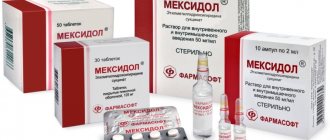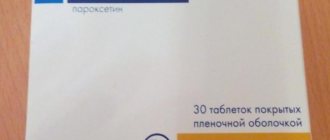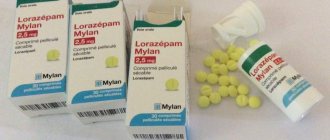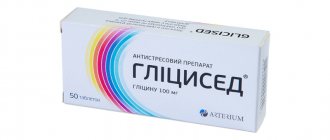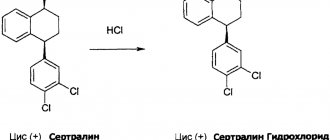Composition and release form
The drug Grandaxin (Grandaxini) is produced in the form of flat round tablets of white or white-gray color, with a chamfer, odorless . On one side there is a mark, on the other there is the inscription “GRANDAX”. The tablets are packaged in blisters, which are placed in cardboard packs of 2 or 6 pieces. Composition of one tablet:
| Compound | Weight, mg |
| Tofisopam (active substance) | 50 |
| Auxiliary components: | |
| lactose monohydrate | 92 |
| gelatin | 3,5 |
| potato starch | 20,5 |
| Magnesium stearate | 1 |
| stearic acid | 1 |
| talc | 2 |
| microcrystalline cellulose | 10 |
Pharmacodynamics and pharmacokinetics
The drug Grandaxin is a tranquilizer that belongs to the group of atypical benzodiazepine derivatives. The drug has an anxiolytic effect (reduction of anxiety ), it has virtually no muscle relaxant, sedative, or anticonvulsant effects. A psychovegetative tranquilizer-anxiolytic eliminates various forms of autonomic disorders and exhibits moderate stimulating activity.
Due to the fact that the medication does not have a muscle relaxant effect, it can be used for myopathy and myasthenia. Due to the atypical chemical structure compared to classical benzodiazepines, therapeutic doses of Grandaxin do not potentiate the effect of alcohol and do not cause the development of mental and physical dependence or withdrawal syndrome. Grandaxin group - daytime tranquilizers.
After oral administration of the tablets, the substance is quickly absorbed into the blood through the gastrointestinal tract, reaching a maximum concentration after two hours, after which it decreases exponentially. Tofisopam does not accumulate, its metabolites are inactive, their half-life is 6-8 hours. Residues of the drug are excreted in urine (in the form of glucuronic conjugates) and feces.
Pharmacological properties
Pharmacodynamics
Tofisopam, the active substance of Grandaxin, is an atypical benzodiazepine derivative, which is characterized by an anxiolytic effect, practically not accompanied by anticonvulsant, muscle relaxant and sedative effects. It refers to psychovegetative regulators that eliminate various forms of autonomic disorders.
Due to the atypical chemical structure, the drug, when taken in recommended doses, practically does not lead to the development of withdrawal syndrome, as well as physical and mental dependence. Grandaxin is a daytime anxiolytic.
Pharmacokinetics
When taken orally, tofisopam is quickly and almost completely absorbed from the gastrointestinal tract. The maximum concentration of the substance in the blood plasma is reached 2 hours after administration, after which its level decreases monoexponentially. Tofisopam does not have a cumulative effect, and its metabolites do not have pharmacological activity.
Indications for use of Grandaxin
The manufacturer's instructions contain a list of diseases and painful conditions that serve as a reason for prescribing Grandaxin:
- neuroses of various origins (apathy, anxiety, obsessive experiences, etc.);
- reactive form of depression with moderately expressed psychopathological signs;
- post-traumatic stress;
- cardialgia (as part of complex treatment or as monotherapy);
- premenstrual emotional disorder;
- menopausal condition (as part of complex treatment or in monotherapy);
- withdrawal syndrome;
- muscle atrophy caused by neurotic disorders;
- myasthenia gravis, myopathies and other painful conditions with neurotic signs, provided that the use of anxiolytic drugs with a strong muscle relaxant effect is contraindicated;
- vegetative-vascular dystonia
Methods of dealing with unpleasant syndrome
It is important to know what to do if such a clinical picture develops. Often, pathology can be dealt with at home. Good results are demonstrated by the use of breathing exercises. Special exercises normalize the functioning of the nervous system due to the rhythm of movements and normalization of oxygen supply to the brain. There are several guidelines for self-soothing that are actively used in psychiatric and neurological practice.
When withdrawal symptoms develop, mild anxiolytic drugs, such as Afobazole, are used, and a return to higher dosages of the previously used drug is also practiced. This makes it possible to combat the development of hypersensitivity of nerve structures in response to a decrease in the concentration of the tranquilizer in the body. The duration of gradual withdrawal of psychotropic drugs varies from 4 to 8 weeks.
The development of withdrawal syndrome is also possible with proper dosage reduction. In this case, patients also require medication support, which will allow them to gradually stop using tranquilizers. For these purposes, mild sedatives, mainly plant-based, are used. These include medications such as Novopassit and Persen, as well as tincture of valerian and other herbs. Before using medications, consult a doctor. Some patients benefit from attending psychotherapy sessions, both while taking tranquilizers and when stopping them.
The tactics to combat withdrawal syndrome also depend on the duration of their use and dosage. If the patient has been on the drug for 3 to 4 months or more, the risk of withdrawal is greatly increased even if the rules for gradual withdrawal are followed. In such cases, doctors recommend inpatient treatment, which will create favorable conditions for the patient when symptoms of withdrawal syndrome appear. At the same time, all medical institutions involved in rehabilitation are private, which means payment for staff services and placement in an inpatient department is required.
Behavioral therapy is also widely used, especially when taking tranquilizers is aimed at combating mental disorders and cognitive impairment. This treatment can be carried out on an outpatient basis. Communication with a psychologist, both individually and in group sessions, helps improve the patient’s condition. It is important to understand that the use of tranquilizers is symptomatic, that is, it does not cure the existing pathology. Anxiolytic drugs help the patient cope with his own emotional problems so that he can reconsider his behavior and outlook on life. In order to avoid the unpleasant consequences of such self-analysis, careful monitoring of the rehabilitation process by a doctor is required.
How to take Grandaxin
The tablets are intended for oral use. The exact dosage is selected individually, based on the patient’s general well-being, tolerability of the components and the clinical degree of the disease. According to the instructions, adult patients are prescribed Grandaxin 1-3 times a day, 50-100 mg (1-2 tablets). The maximum permissible daily dosage is 300 mg. For occasional use of the drug, the dose will be one or two tablets. For age categories of patients (over 65 years), as well as for those suffering from renal failure, the dose is halved.
special instructions
The characteristics of the active substance Grandaxin on the body made it necessary to note the following special instructions in the instructions:
- Grandaxin is not recommended for use as monotherapy for depressive conditions, as the risk of aggression and suicidality increases.
- With slow mental development or impaired renal and liver function, the likelihood of side effects increases.
- Under regular medical supervision, patients with depersonalization and organic brain damage (for example, atherosclerosis) should take the medicine.
- If you are intolerant to lactose or galactose, you should be aware that the drug contains 92 mg of lactose monohydrate. The drug is not prescribed for lactase enzyme deficiency.
- Tofisopam (active substance) may increase the seizure threshold.
- The drug does not affect concentration.
Who is the drug indicated for?
The drug is indicated “for nerves” - to help patients with various forms of neuroses, neurotic conditions, which are combined with increased levels of stress, emotional overstrain, anxiety, decreased performance against a background of moral exhaustion. Also, indications for the use of Grandaxin tablets are:
- vegetative-vascular dystonia;
- prolonged depression, loss of strength;
- obsessive states;
- poor mental adaptation to new conditions;
- pain in the heart area of a functional nature or associated with autonomic disorders;
- withdrawal syndrome.
WE RECOMMEND THE ARTICLE!
haloperidol quickly relieves severe symptoms of mental disorders. Read more >>
The medicine can be prescribed in a post-stress state, as well as after suffering mental trauma. It will help correct the patient’s condition during a course of treatment. In women, indications for use are mental disorders and neuroses during menopause, with PMS (premenstrual syndrome).
For depression, Grandaxin is indicated as monotherapy if there are no severe symptoms.
Since there is no relaxation of muscle fibers when using Grandaxin, it is widely prescribed for myopathy - primary muscle damage associated with impaired nerve transmission. The drug can also be taken for myasthenia gravis, muscle weakness of an autoimmune nature.
Drug interactions
The sedative Grandaxin has a number of restrictions on drug interactions. The instructions for use indicate possible combinations:
- Concomitant use of the drug with Tacrolimus, Cyclosporine, Sirolimus, Clonidine is contraindicated.
- Tofisopam increases the plasma concentration of medications that are metabolized by the same isoenzyme as it.
- Grandaxin enhances the effects of drugs that suppress the functions of the central nervous system. These include general anesthesia, histamine receptor blockers, analgesics, antipsychotics, antidepressants, sleeping pills, and dopamines. The combination of such medications can lead to respiratory depression and sedation.
- Ethanol, liver enzyme inducers, antiepileptic drugs, barbiturates, nicotine increase the metabolism of tofisopam, which reduces its concentration in the blood and weakens the effect.
- Antifungal agents Ketoconazole and Itraconazole slow down the hepatic metabolism of Grandaxin, which increases its plasma concentration.
- Antihypertensive drugs and calcium channel blockers enhance the effectiveness of the drug.
- Beta blockers slow down the metabolism of the active substance.
- Tofizopam increases the level of Digoxin in the blood and negatively affects the anticoagulant effect of warfarin.
- Long-term use of Disulfiram inhibits the metabolism of the active ingredient.
- Antacids negatively affect the rate of absorption of the drug.
Reviews from patients who took the drug
With the onset of menopause, life seemed to collapse. Increased irritability and menopausal symptoms made it difficult to do usual activities.
I had to see a doctor. After 2 months of therapy using Grandaxin, I was able to return to my favorite job and improve my general condition (emotional and physical).
Together with my wife we are raising a grandson. After his parents left, he became uncontrollable.
But the most difficult time came when the child reached adolescence. Anxiety disorders prevented him from not only studying, sleeping normally, and performing his duties.
The neurologist prescribed therapy with Grandaxin. It took more than one month to restore the psycho-emotional background of the grandson. But the drug coped with the task.
Grandaxin and alcohol
Tofisopam reduces the negative effect of ethanol on the nervous system, and alcoholic drinks increase the metabolism of the drug. This leads to a decrease in the effectiveness of the product. Because of this, it is forbidden to take alcohol, alcohol-containing drinks or medications during medication therapy . Side effects of this combination will be an increased load on the liver and a high risk of poisoning.
Will Grandaxin help get rid of VSD?
The results of clinical studies show that Grandaxin makes life easier for patients, adding optimism. However, Grandaxin is not enough for a complete recovery from the disease. Treatment will be more successful if you use the drug Grandaxin with antidepressants.
By adhering to the following recommendations, you can speed up treatment with Grandaxin and forget about VSD forever:
- Meditation and yoga classes;
- Regular dousing with cold water;
- Rejection of bad habits;
- Regular exercise;
- Balanced diet;
- Walks in the open air;
- Avoiding stressful situations;
- Drinking decoctions and teas with a soothing and relaxing effect;
- Activities according to your own interests and hobbies;
- Maintaining a positive atmosphere at home and at work.
The drug Grandaxin is often prescribed for VSD to relieve symptoms: stress, depression and nervousness. The patient's psychological condition immediately improves. With long-term use, Grandaxin does not lead to an overdose and rarely causes side effects.
Side effects of Grandaxin
During therapy with Grandaxin, adverse reactions are possible. Instructions for use highlight the following:
- seizures, headache, confusion, insomnia;
- congestive jaundice, loss of appetite, dry mouth, constipation, nausea, flatulence;
- allergy, scarlet-like exanthema, skin itching;
- muscle pain, tension;
- psychosis, irritability, phobias;
- respiratory depression.
Overdose
If you take Grandaxin tablets in a dose higher than the instructions indicate (over 50-120 mg per kg of body weight), then suppression of the functions of the central nervous system is possible . This is manifested by vomiting, coma, confusion, epileptic seizures, and respiratory depression. If symptoms are severe, it is recommended to rinse the stomach; vomiting should not be induced. Activated carbon is indicated to prevent drug absorption. Physicians should monitor the patient's vital signs.
In case of respiratory depression, artificial ventilation is indicated; the administration of central nervous system stimulants is not recommended. Hypotension is eliminated by intravenous administration of solutions, transferring the patient to a lying position, legs higher than head. If there is no effectiveness in restoring normal blood pressure using conventional methods, it is possible to administer norepinephrine, dopamine, or norepinephrine. Forced diuresis and dialysis are ineffective. Emergency cases require the use of a specific benzodiazepine antagonist, Flumazenil.
Contraindications
The drug should be used with caution in persons with angle-closure glaucoma, respiratory failure (acute), epilepsy, respiratory distress (chronic, decompensated). Clinical studies and pharmacokinetic features led to the introduction of a number of direct contraindications into the instructions:
- stage of decompensation with respiratory failure;
- conditions accompanied by aggressiveness, severe depression or noticeable psychomotor agitation;
- diagnosed respiratory failure syndrome during sleep;
- first trimester of pregnancy and breastfeeding period;
- galactose intolerance, lactase deficiency (congenital), galactose and glucose malabsorption syndrome;
- hypersensitivity to the components included in the composition.
Grandaxin's analogs
The drug can be replaced with drugs from the group of benzodiazepines - they have the same effect and have a similar or slightly different composition. Drug analogues include:
- Afobazole – tablets with an anxiolytic effect based on afobazole (morpholinoethylthioethoxybenzimidazole dihydrochloride);
- Gidazepam is an anticonvulsant tablet medicine containing the component of the same name, gidazepam;
- Diazepam – tranquilizing pills and ampoules with a solution based on diazepam;
- Neurol is an analogue of Grandaxin in the form of tablets with a muscle relaxant effect based on alprazolam;
- Relanium is an anti-anxiety solution for parenteral administration containing diazepam as an active ingredient;
- Tazepam – sedative tablets based on oxazepam;
- Phenazepam is an anxiolytic tablet and solution for injection containing bromodihydrochlorophenylbenzodiazepine.
Prescription of tranquilizers
Psychotropic drugs are actively used in medical practice. The most widely used drugs are from the group of antidepressants, since they have a mild but pronounced effect. Tranquilizers are designed to suppress anxiety, fear and aggression. Their use is often associated with the development of addiction. Anxiolytic drugs are prescribed for the following pathologies:
- Vegetative-vascular dystonia is a common problem today, the treatment of which is based only on symptom relief. Against the background of the disease, mental disorders often develop, as well as pain syndrome of neurogenic origin. To relieve such manifestations, drugs such as Atarax, Adaptol, Gidazepam, Tofisopam and Mezapam are used.
- Mental disorders accompanied by panic attacks, increased nervous excitability or tension. Tranquilizers are used in combination with other drugs, and are also used as symptomatic therapy in the development of neuroleptic withdrawal syndrome.
- Withdrawal from alcohol and drug abuse. Because severe cognitive impairment occurs during addiction treatment, pharmacological support for patients is required. For these purposes, both tranquilizers and nootropic drugs, such as Picamilon, are used. “Grandaxin” and “Afobazol” for withdrawal symptoms help cope with the development of an obsessive state.
If there is no effect from taking tranquilizers for mental disorders such as schizophrenia, more potent drugs are used. Antipsychotics based on olanzapine, for example, Zyprex, are prescribed.
Grandaxin price
The tranquilizer Grandaxin is sold in pharmacies at prices that depend on the number of tablets in the package and the pricing policy of sellers. In Moscow, the approximate cost of the drug will be:
| Pharmacy name | Type of medicine release | Price, rubles |
| WER.RU | Tablets 50 mg 20 pcs. | 352 |
| Tablets 50 mg 60 pcs. | 819 | |
| ZdravZone | 50 mg 20 tablets | 361 |
| 50 mg 60 tablets | 860 | |
| Pharmacy IFC | 60 tablets of 50 mg | 997 |
| 20 tablets of 50 mg | 466 | |
| Pills.ru | Tablets 50 mg 20 pcs. | 366 |
| Tablets 50 mg 60 pcs. | 830 |

